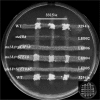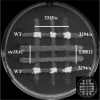Ste18p is a positive control element in the mating process of Candida albicans
- PMID: 24489040
- PMCID: PMC4000101
- DOI: 10.1128/EC.00320-13
Ste18p is a positive control element in the mating process of Candida albicans
Abstract
Heterotrimeric G proteins are an important class of eukaryotic signaling molecules that have been identified as central elements in the pheromone response pathways of many fungi. In the fungal pathogen Candida albicans, the STE18 gene (ORF19.6551.1) encodes a potential γ subunit of a heterotrimeric G protein; this protein contains the C-terminal CAAX box characteristic of γ subunits and has sequence similarity to γ subunits implicated in the mating pathways of a variety of fungi. Disruption of this gene was shown to cause sterility of MTLa mating cells and to block pheromone-induced gene expression and shmoo formation; deletion of just the CAAX box residues is sufficient to inactivate Ste18 function in the mating process. Intriguingly, ectopic expression behind the strong ACT1 promoter of either the Gα or the Gβ subunit of the heterotrimeric G protein is able to suppress the mating defect caused by deletion of the Gγ subunit and restore both pheromone-induced gene expression and morphology changes.
Figures







Similar articles
-
Heterotrimeric G-protein subunit function in Candida albicans: both the alpha and beta subunits of the pheromone response G protein are required for mating.Eukaryot Cell. 2008 Sep;7(9):1591-9. doi: 10.1128/EC.00077-08. Epub 2008 Jul 25. Eukaryot Cell. 2008. PMID: 18658257 Free PMC article.
-
Identification and characterization of MFA1, the gene encoding Candida albicans a-factor pheromone.Eukaryot Cell. 2007 Mar;6(3):487-94. doi: 10.1128/EC.00387-06. Epub 2007 Jan 5. Eukaryot Cell. 2007. PMID: 17209123 Free PMC article.
-
Site-directed mutations altering the CAAX box of Ste18, the yeast pheromone-response pathway G gamma subunit.Genetics. 1994 Aug;137(4):967-76. doi: 10.1093/genetics/137.4.967. Genetics. 1994. PMID: 7982577 Free PMC article.
-
Mating in Candida albicans and the search for a sexual cycle.Annu Rev Microbiol. 2005;59:233-55. doi: 10.1146/annurev.micro.59.030804.121310. Annu Rev Microbiol. 2005. PMID: 15910278 Review.
-
Through a glass opaquely: the biological significance of mating in Candida albicans.Curr Opin Microbiol. 2004 Dec;7(6):661-5. doi: 10.1016/j.mib.2004.10.003. Curr Opin Microbiol. 2004. PMID: 15556040 Review.
Cited by
-
Deletion of a Yci1 Domain Protein of Candida albicans Allows Homothallic Mating in MTL Heterozygous Cells.mBio. 2016 Apr 26;7(2):e00465-16. doi: 10.1128/mBio.00465-16. mBio. 2016. PMID: 27118591 Free PMC article.
References
Publication types
MeSH terms
Substances
Grants and funding
LinkOut - more resources
Full Text Sources
Other Literature Sources
Molecular Biology Databases

